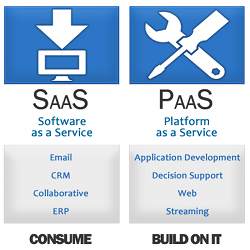
Organizations of all sizes need to make some crucial decisions when it comes to deciding their path to the cloud. While software-as-a-service (SaaS) applications are the most widely used, they are generally limited in the amount of customization they enable, which is why organizations increasingly are adding platform-as-a-service (PaaS) environments to their portfolios, to foster development of their own custom cloud applications.
Some SaaS application providers make their own PaaS environments available to customers that want the best of both worlds, but for the most part, IT organizations are finding it prudent to standardize on one PaaS environment in order to provide developers with a single consistent framework for creating applications.
"This isn’t an either-or equation," said veteran IT journalist Mike Vizard. "Most organizations are going to invoke multiple SaaS applications alongside a PaaS environment that is used to host their custom applications running in the cloud or on premise."
SaaS hosts (and leases) software in the cloud to save hard drive space and datacenter maintenance costs for the user—although hybrid configurations use on-premises resources as well. As a result, however, the user is stuck using the SaaS server’s spectrum of available software.
PaaS goes the extra step of allowing the user to add on other software, usually communicating with its core programs using application programmer interfaces (APIs) and often facilitated by an integrating-PaaS (iPaaS) vendor that sets up the flow of data among programs on premises and in the cloud. Users who find no available software to their liking can "roll their own" apps using an aPaaS (application plaform as a service) vendor who integrates custom applications using the host’s software design kit (SDK).
"Don’t let the name ‘platform’ mislead you—PaaS and SaaS are both software. PaaS just lets the user add new capabilities to the same user interface, which is an increasingly popular trend," said Vizard. "PaaS comes with APIs and SDKs, and most of the big players in the Cloud Foundry Foundation consortium will also allow you to PaaS, or hire and aPaaS or iPaas to do it for you."
The advantage for users of SaaS and PaaS is that they merely have to run a thin client (essentially a keyboard and display configured as a web terminal). IBM Bluemix, Amazon Web Services, Hewlett Packard Enterprise, and 63 other vendors use the Cloud Foundry Foundation as their common user interface (UI) and shared resource library. SalesForce, Microsoft, Google, RedHat, and many others, however, provide their own proprietary PaaS UI’s, application infrastructure, and middleware.
According to Gartner Inc. (Stamford, CT), however, most vendors are not taking full advantage of the benefits of PaaS. The market research firm predicts PaaS will grow faster than plain-Jane SaaS in coming years.
Gartner said the world PaaS market last year amounted to $5.67 billion, and that amount will almost double to $10.68 billion by 2018, driven by the advantages of extending user system capabilities relatively easily and inexpensively via aPaaS and iPaaS services.
Most vertical software businesses are getting into PaaS, carving out their own niches and extending the PaaS revenue base, to the detriment of the market’s early entrants. Leading PaaS vendor IBM lost 12.8% market share last year, and second-ranked PaaS vendor Oracle lost 3.8% market share, according to Gartner. The market research firm attributed the losses to vertical aPaaS and iPaaS vendors that extended and stitched together diverse applications with a common user interface using less-expensive cloud resources, while integrating all-in-one application suites that added capabilities like payroll, human resources management, tax analytics, investment analytics, and 401K management to the traditional customer relationship management capabilities of SaaS.
For instance, iCIMS (Internet Collaborative Information Management Systems) specializes in recruitment, retention, and management of employees. Its PaaS—a Talent Acquisition Suite, which began life as a SaaS suite—consists of three core components: a candidate relationship manager for identifying qualified candidates and attracting them to a company; an applicant tracking system that manages setting up interviews, running background checks, and all the other details leading up to a job offer, and an On-Board app that manages after-hiring chores ranging from filling out tax forms to determining the assets a new employee needs to do their job to getting them behind a desk and working.
"We were successful for 15 years offering our three basic services as SaaS, but found that our customers wanted to integrate them with other systems," said iCIMS vice president of technology Al Smith. "Since moving to a PaaS model, our users have built over 400 integrations with over 300 software vendors. PaaS allows our customers to extend our capabilities themselves. We opened up our software with APIs and SDKs which customers can use to integrate other vendors’ software, or write their own, and use those applications on our platform with the same user interface."
iCRM’s Talent Acquisition Suite (now called Unifi) has always been delivered over the Internet, running either on iCRM’s in-house hardware or, more recently, using cloud resources. All the programs are written in Java using a structured query language (SQL) database, with APIs that can run in an on-premises datacenter, in a private cloud, or on a hybrid cloud using a mix of Windows and Linux servers.
"Platform as a Service within talent acquisition is very encouraging to see," said Erik Kostelnik, co-founder and CEO of iCIMS client Text Recruit. "Working with iCIMS has enabled TextRecruit to experience hyper-growth and provide tremendous, measurable value to our shared customer base."
Said Julie Loubaton, director of talent acquisition at industrial distributor and iCIMS client HD Supply , "UNiFi allows us to manage and oversee all of our hiring technologies in one, easy-to-use platform. iCIMS is at the core of our recruiting efforts and we’re excited to see this vision come to life."
R. Colin Johnson is a Kyoto Prize Fellow who has worked as a technology journalist for two decades.



Join the Discussion (0)
Become a Member or Sign In to Post a Comment